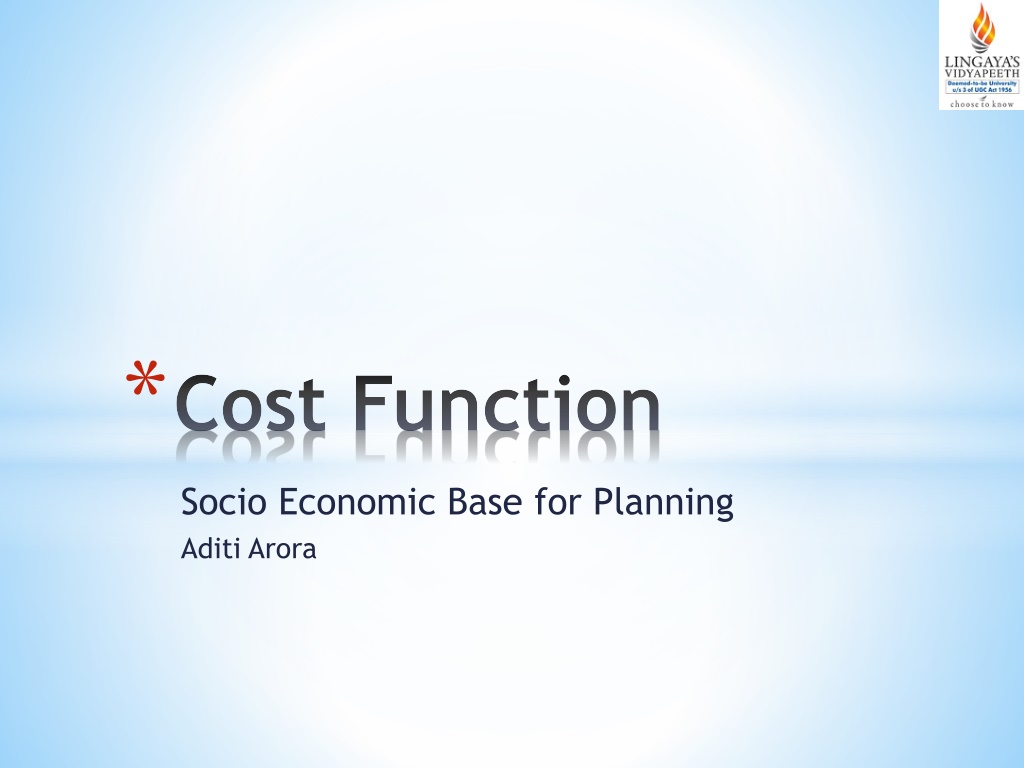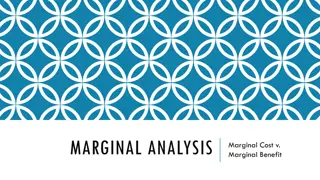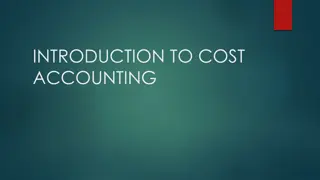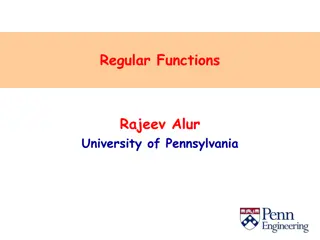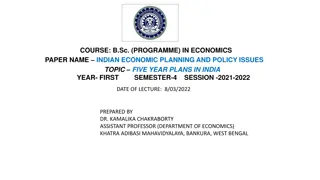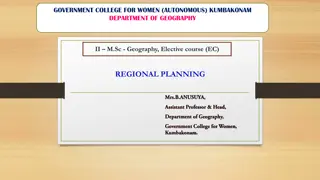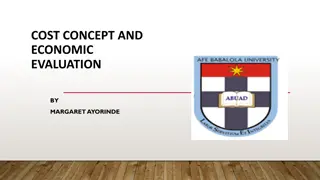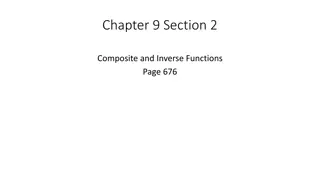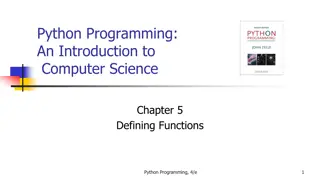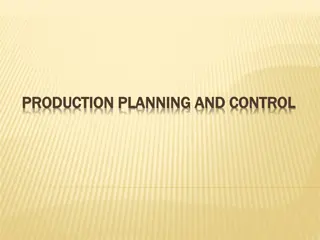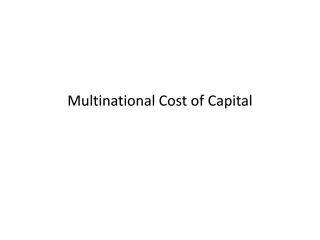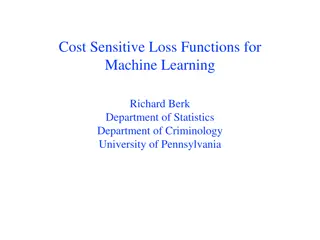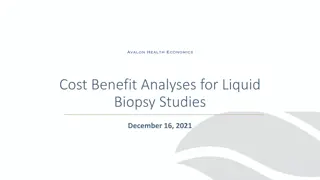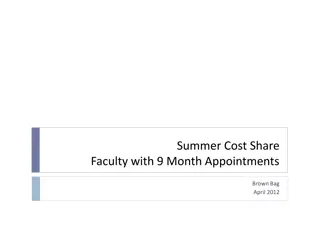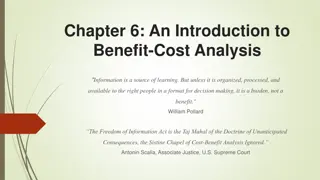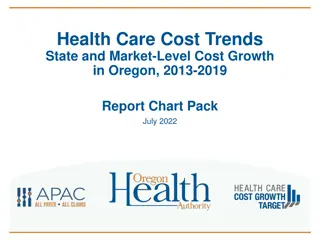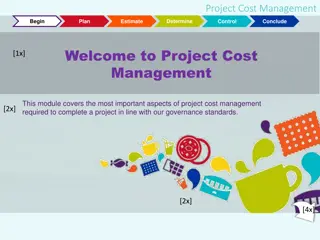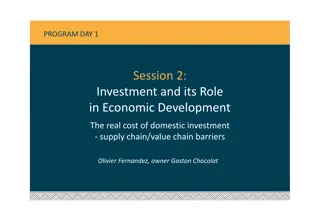Understanding Cost Functions and Economic Planning with Aditi Arora
Explore the concept of cost functions in socio-economic planning with Aditi Arora, delving into the classification of costs, variable and fixed costs, opportunity costs, and more. Learn about total, average, and marginal costs, essential for making informed entrepreneurial decisions.
Uploaded on Sep 26, 2024 | 0 Views
Download Presentation

Please find below an Image/Link to download the presentation.
The content on the website is provided AS IS for your information and personal use only. It may not be sold, licensed, or shared on other websites without obtaining consent from the author. Download presentation by click this link. If you encounter any issues during the download, it is possible that the publisher has removed the file from their server.
E N D
Presentation Transcript
*Cost Function Socio Economic Base for Planning Aditi Arora
Cost of Product *It is the sum total of payments made to the inputs employed in its production. *Having an estimate of costs involved is crucial for helping many a entrepreneurial decision. *In different situations the data to be reckoned and the form in which the information on costs is sought could differ. *Hence varying labeling of costs. *Some them are explained in the following.
Classification of Costs *Opportunity Cost : Cost of any decision is measured in terms of value of next best that has been sacrificed *Implicit and Exploit Costs: Implicit costs are those opportunity costs that does not involve a physical cash payment. Explicit costs are those that involve cash payments to other parties. *Economic costs: The total cost that covers the explicit as well as implicit costs involved in production and also remuneration that entrepreneur is entitled to, payment towards the assets and other capital provided by owners.
Classification of Costs *Variable cost: Payments that are made to variable inputs such as raw materials, wages to temporary labour, machine time etc. They vary with the scale of operations in short run *Fixed costs: The payments that are to be made irrespective of the scale of Production. These include the salaries of permanent staff , depreciation on machinery, rent and maintenance of buildings, contractual commitments (loan repayments, Insurance etc), pre fixed rentals and costs of maintaining common facilities,
Classification of Costs *Indirect costs: Fixed costs are referred by some as indirect costs because that while working out the unit costs their apportionment is done on some arbitrarily chosen formula. *Direct Costs: Payments made to variable inputs could be directly related to the output units
Cost Function *The Cost function indicates the minimum achievable cost for producing various quantities of the product. *Cost functions are derived basically from production function which identifies the efficient combination of factors of production for achieving a particular level of output given the technology of production etc.
Total, Average and Marginal Cost *Total Cost (TC): covers both variable and fixed costs *Average Cost(AC): total cost/total units of output *Marginal Cost (MC): addition to the total cost incurred for production of last unit of output *Cost Schedule is the table indicating costs incurred at different levels of outputs. *Costcurve its graphical representation.
Isocost Line *Isocost lines are loci of various combination of inputs that a firm could buy and marshal for production under given technology and unit prices of those inputs at a predetermined level of total budget. *When factors of production are only two say labour (L) and Capital (K) and they are combined in different proportions to produce a product but results in the same level total cost, then different combinations of K &L can be represented in form of a straight line connecting L on X-axis and K onY-axis (assuming that the prices of K&L and Technology of production as given). *Parallel shifts in them happen according as the total cost proposed to be spent.
Break Even Point *A break even point is that level of production output where the firm concerned neither earns any profit nor incurs any loss i.e. the total revenues expected to be earned are just equal to the total costs required to be spent. *Break-even analysis helps the firm concerned in planning its long term business strategies.
Break Even Point *Though, it is a rough and ready exercise, in a way it provides clues as to the detailed exercises that need to be carried in regard to demand forecasts, revenues earnable and cost savings to be explored etc. *It also helps in deciding the products mix, choice production technology and strategies for marketing and the level of output where the profit margins are optimum.
Long and Short Costs *A production firm s short term total costs vary according as the quantities of variable inputs employed and their prevailing unit prices. *Other major influencing factors here include motivation and skills displayed by the work force, the way vendors of raw material honour contractual agreements in regard to quantity, quality, timings of their supplies, Inventories required to be maintained both regard to inputs as well as outputs and taxes.
Long and Short Costs *In long run a firm would have sufficient time and opportunity to carry detailed investigations into factors causing diseconomies of scale, go in for entirely new production technologies, plants, better input combinations for cost cutting, adopt product to changing requirements of clients and so on to ensure that the given level of output is accomplished at minimum possible cost. *Thus the long run average cost curve of a firm could be taken as the loci of minimum possible short term average costs for different scales of production operations.
Optimal Production and Pricing *A firm would generally prefer to fix both its quantity of out put and the price at which it would like to offer in the market to cover its average costs and reasonable profits(for undertaking entrepreneurial risks)on the basis of information it had about isoquants and isocosts. *The optimum levels of its production expansion is along the lines that connects tangent points where isocost lines meets the isoquants.
Economies of Scale *A firm would be constantly endeavoring to maximize its profits (or minimize the losses). *Towards this, it may continue to increase its scale of operations as long as the average cost continue to decline(decrease the level of operations in case average cost is rising). *An equilibrium position is reached where average cost come down to the minimum possible level and Average cost equals marginal cost. *Situations of decreasing average costs is referred as a the phase of Economies of Scale and ones of increasing average costs as phase of Dis-economics of Scale.
Economies of Scale: Contributing factors *Real Economies of Scale: *Production: Unbundling of functions and division of labour; Motivation for labour towards skills specialization; Fuller utilization of fixed assets/sunk capital; Gaining confidence to go in for frontier technologies ; fix realistic inventory levels. *Procurement of inputs: Bargaining with venders from position of strength, Spreading vender net work to get best quality inputs, avoid uncertainties.
Economies of Scale: Contributing factors *Sales: Establishing wider sales network to penetrate to new markets by employing large number of sales men, show rooms, advertisements to the clients targeted. *Managerial: Decentralization of decision making and entrusting functional responsibilities to technocrats, Instituting controls by exception systems. *Transportation and Storage: concessions/savings in transporting products to sales locations and maintaining stores there.
Economies of Scale: Contributing factors *Captive Facilities : For electricity generation, mining of minerals, waste treatment plants. *Pecuniary Economies of Scale: Economies accruing on account of favourable decisions taken by the venders, Clients, Lending Financial Institutions, Advertisers etc. Better qualified seeking employment of firm in question.
